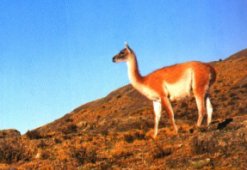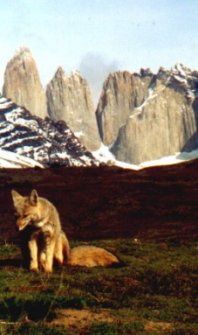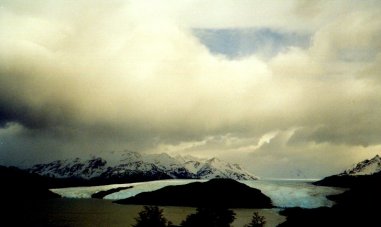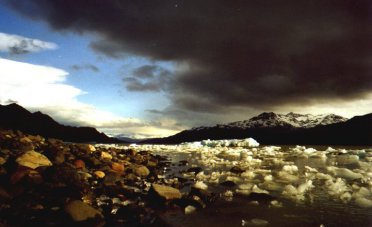Chile - Argentina 2000: Torres Del Paine
|
Situated 145 km northwest of Puerto Natales and
covering 181.414 hectares, the national park Torres Del Paine,
a Unesco Biosphere Reserve, is a must for its wildlife and spectacular
scenery. The scenery is superb, with constantly changing views of
fantastic peaks, ice-fields, vividly coloured lakes of turquoise,
ultramarine and grey, and quiet green valleys. In the center of
the park is a granite massif from which rise the Torres (towers)
and Cuernos (horns) of Paine, oddly shaped peaks of over 2600 meters.
The valleys are filled by beautiful lakes at altitudes of 50 meters
to 200 meters above sea level.
|
aaa | 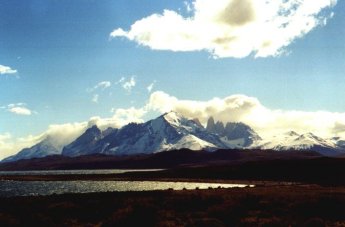 |
|
|
|
The guanaco has adapted superbly to the steppe - its thick wool protects it from the cold and the wind, its feeding habits do not deplete the vegetation, and its hooves do not damage the steppe's grasses. Contrast this with the domesticated sheep which have gravely damaged the vegetation and soil of the Patagonian steppe. The guanaco lives in groups of varying size, the most legendary being the great herds of hundreds of guanacos recorded by Francisco P. Moreno during his expeditions. In the 20th century, guanaco hunting intensified, reducing its numbers. Before this, it had only be hunted by the aboriginal people, who ate its meat and used its pelt for clothing, without seriously affecting its population. Nevertheless, guanacos continue to thrive and they are frequently seen in the areas off the main roads, particularly in the many protected areas of the region, such as Valdés Peninsula and Cabo Dos Bahias in Chubut, and Torres del Paine in Magallanes | ||
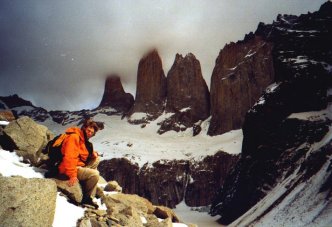
|
|||
| From Campamento Torres, a steep and sometimes ill-marked trail climbs through patchy beech forests to the barren tarn above, which provides dramatic views of the nearly vertical Torres. | |||
The gray fox is the most common
carnivore of the Patagonian steppe. They are relatively easy to observe,
especially along the secondary roads that connect the towns and estancias.
The animal is very well adapted to the demands of the steppe's ecosystem,
skilled at taking advantage of every opportunity to feed, both hunting
its own prey and taking possession of found carrion. Its fine fur
has traditionally been en economic resource for the people of the
area, who hunt the fox using traps. While the gray fox is not an endangered
species, it is necessary to regulate these hunting activities to keep
their numbers stable and their population healthy, while giving an
economic boost to the ailing local economy. A similar plan of action
is also needed for the Patagonian red fox, which is less abundant
than the gray fox.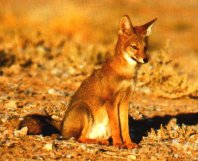
 (Image: Patagonia, The last Wilderness) |
|||
| In calling up images of the past, I find that the plains of Patagonia frequently cross before my eyes; yet these plains are pronounced by all wretched and useless. They can be described only by negative characters; without habitations, without water, without mountains, they support merely a few dwarf plants. Why then, and the case is not peculiar to myself, have these arid wastes taken so firm a hold on my memory? Why have not the still more level, the greener and more fertile Pampas, which are serviceable to mankind, produced an equal impression? I can scarcely analyze these feelings: but it must be partly owing to the free scope given to the imagination. The plains of Patagonia are boundless, for they are scarcely passable, and hence unknown; the bear the stamp of having lasted, as the are now, for ages, and there appears to be no limit to their duration during future time. If, as the ancients supposed, the flat earth was surrounded by an impassable breadth of water, or by deserts heated to an intolerable excess, who would not look at these last boundaries to man's knowledge with deep but ill defined sensations? - Charles Darwin | |||
| If we look at a globe, we see that Patagonia is the planet's southernmost region. It makes up the narrowest part of the South American triangle, culminating in a great archipelago with numerous islands of varied size, just 700 miles from the Antarctic peninsula. For a long time now, the name Patagonia has evoked images of enormous expanses of land, of seashores that seem to have sprung from the imagination of Jules Verne, and of mountains and glaciers that form one of the world's most extraordinary geological phenomena, all enveloped in a shroud of solitude and mystery that seduces and delights its scarce settlers as well as travelers and explorers. Patagonia is one of the last spots on earth where nature can still be experienced and observed just as it was at the beginning of time, in all its energy and infinite variety. From an ecological point of view, Patagonia boasts a unique natural wealth, including various botanical and zoological species that exist only in this region of the planet. The region is composed of three natural environments: the coastal regions, the steppe and the southern forests in the Patagonian Andes. The diverse landscapes of these environments are inhabited by flora and fauna that have adapted to their harsh climates of scarce rainfall (except in the western region), virtually relentless and blustering winds, sweltering summers (especially in the northern half), and cruel winters, with heavy snowfall in the southern half (where blizzards have caused serious problems for the rural population). Patagonia was once home to various aboriginal people who arrived with the great migratory drift from North America, which in turn was made up of the descendants of those who had arrived from Asia via the Bering Strait. These hunting, fishing and gathering cultures adapted their ways of life easily to the harsh conditions of the region - until the arrival of the white man. It was at Puerto San Juliàn in Santa Cruz in 1520 that Portuguese explorer Ferdinand Magellan disembarked during his expedition to seek a passage through South America from the Atlantic to the Pacific. Thus began Patagonia's age of European exploration, stimulated by economic, colonizing and scientific interests. This vast territory was discovered little by little; for many it brought disillusionment; for some it proved to be a challenge; and for yet others, it simply inspired awe. Today, for those who appreciate the natural world, Patagonia is one of the world's most alluring places. It is unparalleled for enjoying the mysteries of the unknown, for exploring the kinds of landscapes thought to have been lost forever, and for discovering nature's magnificent ability to surpass all dreams. | |||
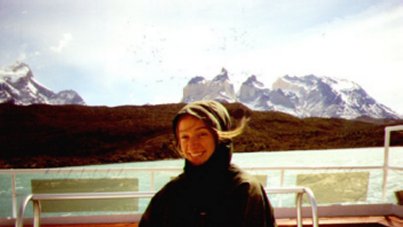 |
|||
|
The park is part of the Paine Massif, which lies
inside the continent from, or east of, the high central Andean spine.
The massif are medium high mountains emerging suddenly from the
plains of the Patagonian steppes. The mountains are granite, capped
by crumbly sedimentary rock that used to lie on the valley floor.
Before the park was acquired by the Chilean government, it belonged
to ranchers who overgrazed and also burned down forests to increase
pasture area. The park is still recovering from this devastation,
and will be for a while. But it's a chance to see what nature will
do, if given a chance. Natural recovery can also be seen, though
the glaciers of the park are in quick retreat - up to 56 feet a
year for the last 90 years, creating a fascinating study of plant
succession and soil build-up from bare rock to forest. The flora
of the park ranges from grassland to southern beech forests. Many
parts of the park were too remote for the cattle ranchers, and exist
today in a pristine state.
|
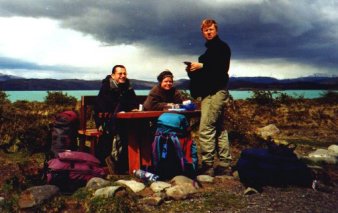 |
||
|
Intro Torres Del Paine NP Glaciares NP Peninsula Valdez Iguazu NP Los Esteros Del Ibera Buenos Aires The Birding Pages |
|||
